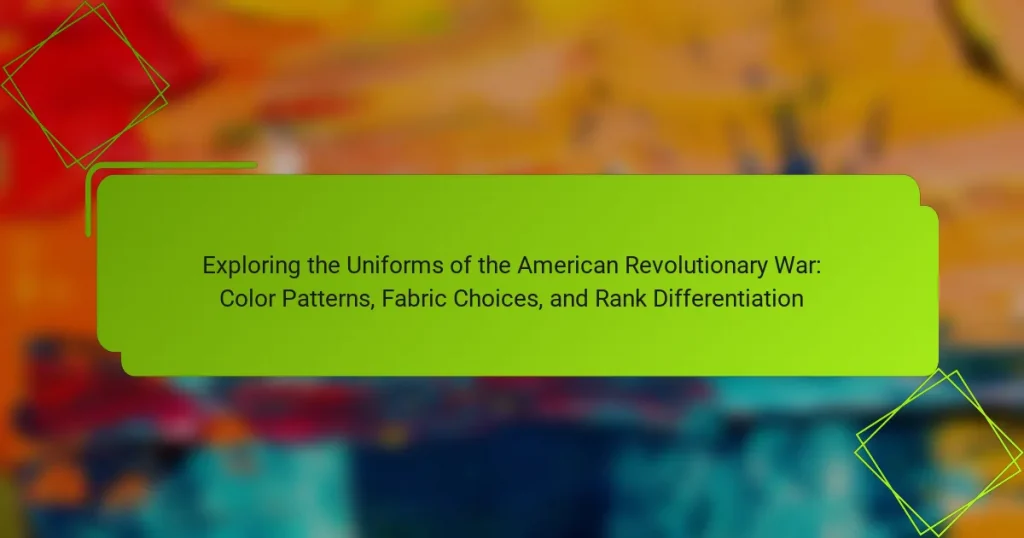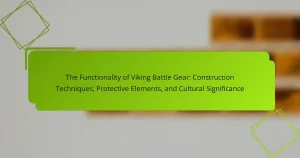The article explores the uniforms of the American Revolutionary War, focusing on key characteristics such as color patterns, fabric choices, and rank differentiation. Distinctive colors like blue for the Continental Army and red for British troops symbolize allegiance and identity. The use of materials, including wool and linen, addresses both durability and comfort needs. Rank differentiation is highlighted through elements like epaulettes and insignia, contributing to military organization and unity. Historical records and preserved uniforms provide context for understanding these elements and their significance in shaping modern military attire.
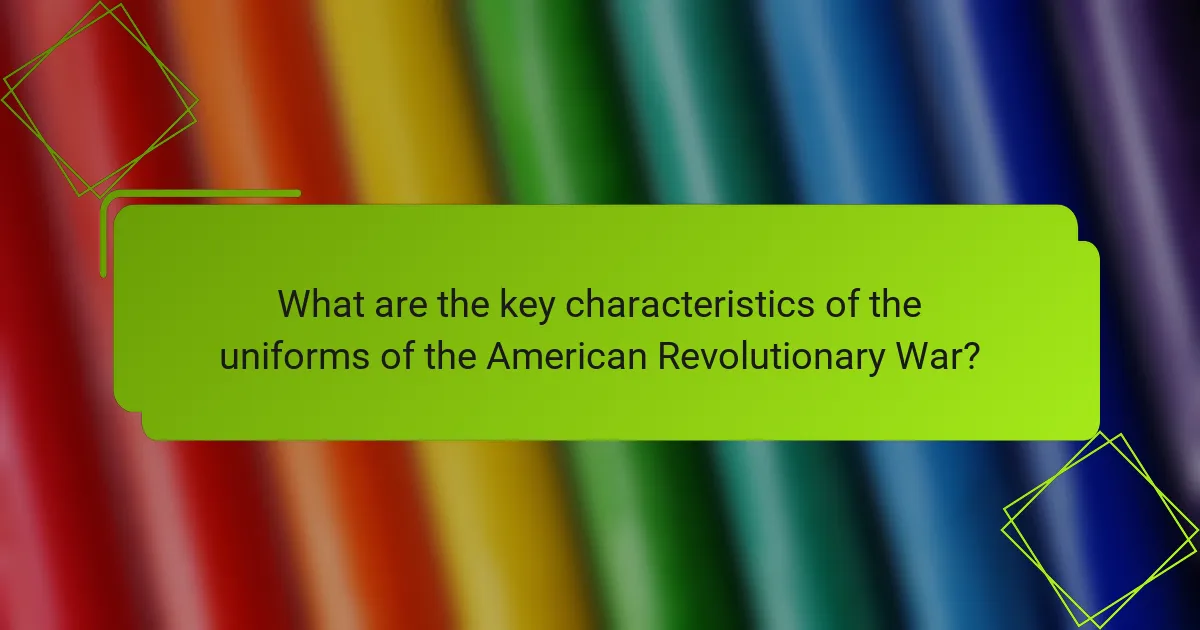
What are the key characteristics of the uniforms of the American Revolutionary War?
The key characteristics of the uniforms of the American Revolutionary War include distinct color patterns, fabric choices, and rank differentiation. Uniforms typically featured a combination of blue, red, and white, symbolizing patriotism and allegiance. The Continental Army predominantly wore blue coats, while British troops favored red uniforms. Fabrics used ranged from wool for durability to linen for breathability, catering to various climates. Rank differentiation was evident through epaulettes, lace, and specific insignia, indicating hierarchy within the military structure. These characteristics not only served practical purposes but also conveyed identity and unity among troops. Historical records, such as uniforms preserved in museums, validate these details about the uniforms used during this pivotal conflict.
How did color patterns influence the identification of military units?
Color patterns significantly influenced the identification of military units during the American Revolutionary War. Distinctive colors helped soldiers recognize their own units on the battlefield. Each regiment often had unique color schemes or patterns on their uniforms. These visual cues were crucial for maintaining order amidst chaos. For instance, British troops typically wore red coats, which became a symbol of their identity. American forces, in contrast, adopted a variety of colors to represent different regiments. This differentiation aided in preventing friendly fire. Historical records indicate that color patterns were essential for troop coordination and morale.
What colors were commonly used in uniforms, and what did they signify?
Common colors used in uniforms during the American Revolutionary War included blue, red, and white. Blue typically signified loyalty and was associated with the Continental Army. Red was primarily worn by British soldiers, symbolizing courage and valor. White often represented purity and was used in various regiments. Each color helped distinguish between different factions and ranks within the military. Historical records show that these colors were chosen based on their visibility and the symbolism they carried, impacting morale and identity on the battlefield.
How did the choice of colors vary between different factions?
The choice of colors varied significantly between different factions during the American Revolutionary War. British forces primarily used red as their uniform color, symbolizing their military tradition. American Continental Army uniforms featured blue, often with white or buff accents, representing unity and patriotism. Loyalist uniforms varied but often included green and brown, reflecting their allegiance to the crown. French forces wore white and blue, showcasing their national colors. Each faction’s color choice served to distinguish them on the battlefield and convey their identity. Historical records confirm these color associations, highlighting their importance in military strategy and morale.
What materials were typically used in the construction of these uniforms?
Wool and linen were typically used in the construction of uniforms during the American Revolutionary War. Wool provided warmth and durability, making it suitable for military wear. Linen was favored for its breathability and comfort in warmer weather. Cotton also emerged as a material choice, particularly for lighter uniforms. The use of these materials reflected the practical needs of soldiers in varying climates. Historical records indicate that wool was the predominant fabric, especially for coats and trousers. Linen was often used for shirts and undergarments. The choice of materials was influenced by availability and cost during the war period.
What types of fabrics were preferred for military uniforms and why?
Wool and linen were preferred fabrics for military uniforms during the American Revolutionary War. Wool provided warmth and durability, essential for soldiers in varying climates. Linen, being lightweight, offered breathability, making it suitable for summer campaigns. Both fabrics were readily available and cost-effective. Wool also had natural water-resistant properties, beneficial for outdoor conditions. Furthermore, the ability to dye wool and linen allowed for distinct colors, aiding in unit identification. Historical records indicate that these fabric choices contributed to both functionality and uniformity in military attire.
How did the fabric choices affect the durability and comfort of the uniforms?
Fabric choices significantly influenced the durability and comfort of uniforms. Wool was commonly used for its resilience and ability to insulate, providing warmth in various weather conditions. Cotton offered breathability and softness, enhancing comfort during long hours of wear. Linen, though less durable, was lightweight and allowed for ease of movement. The blend of these materials contributed to the overall functionality of the uniforms. For instance, wool uniforms were more resistant to wear and tear compared to cotton ones. Historical records indicate that soldiers preferred comfortable fabrics to avoid chafing and discomfort during battles. Thus, the selection of fabric directly impacted both the longevity and wearability of the uniforms.
How did rank differentiation manifest in uniform design?
Rank differentiation in uniform design during the American Revolutionary War was evident through color, embellishments, and cut. Different ranks wore distinct colors to signify hierarchy. For example, generals often wore brighter and more elaborate uniforms. Officers had specific insignia that indicated their rank. The use of lace, epaulets, and sashes also varied by rank. These design elements helped to visually communicate authority and command on the battlefield. Historical records show that such distinctions were crucial for maintaining order among troops. The British Army, for instance, utilized red coats for rank identification.
What specific features distinguished officers from enlisted soldiers?
Officers in the American Revolutionary War were distinguished from enlisted soldiers by several specific features. Officers typically wore more elaborate uniforms with distinctive insignia. Their uniforms often included epaulets, which signified rank. Officers also had higher-quality fabrics and more decorative elements in their clothing. In contrast, enlisted soldiers wore simpler uniforms without such embellishments. The color patterns of officers’ uniforms were often more varied and vivid compared to the standardized colors of enlisted soldiers. Additionally, officers carried swords, which were not standard for enlisted personnel. These differences were crucial for maintaining order and hierarchy on the battlefield.
How did insignia and embellishments convey rank and status?
Insignia and embellishments conveyed rank and status by serving as visual markers of authority. Different colors, shapes, and designs indicated specific ranks within military hierarchies. For example, officers often wore distinctive insignia on their uniforms to distinguish themselves from enlisted soldiers. These symbols included epaulettes, badges, and unique patterns that signified higher command. The use of gold or silver thread in embroidery further emphasized rank and prestige. Historical records show that British officers in the American Revolutionary War wore specific insignia that identified their regiment and rank. Such visual cues were essential for maintaining order and discipline on the battlefield.
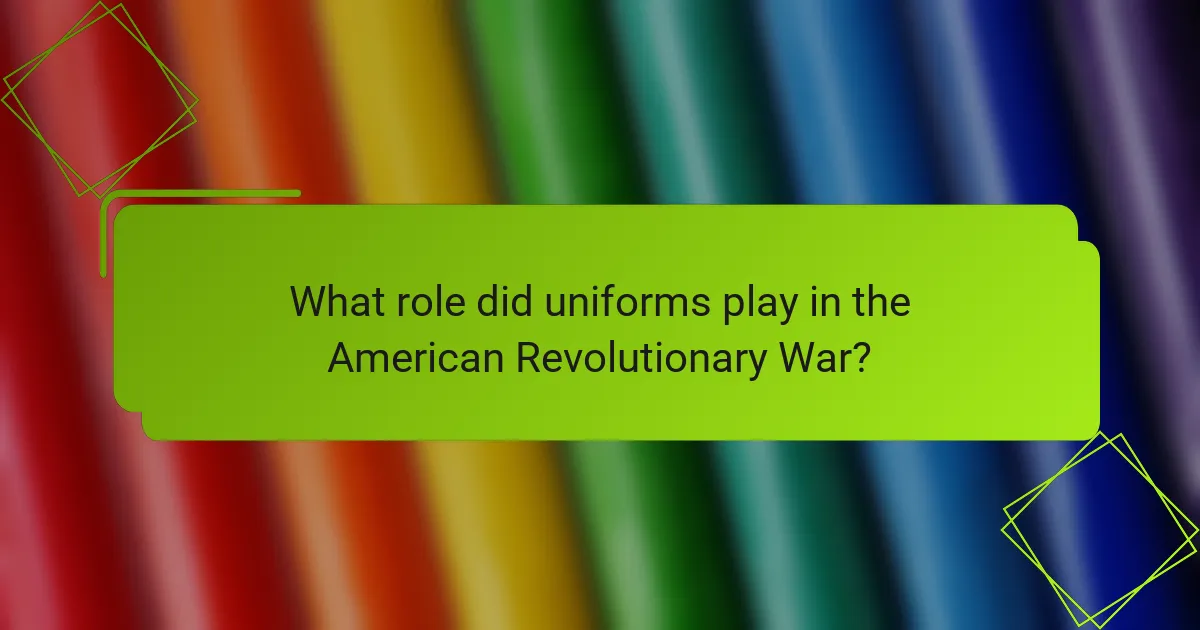
What role did uniforms play in the American Revolutionary War?
Uniforms played a crucial role in the American Revolutionary War. They served to identify soldiers’ allegiance and rank. Uniforms distinguished the Continental Army from British forces. Specific colors indicated different regiments and units. This visual differentiation helped in battlefield coordination. Uniforms also fostered a sense of unity and morale among troops. The adoption of standardized uniforms was essential for discipline. Historical records show that uniforms contributed to the overall organization of military forces.
How did uniforms contribute to military strategy and morale?
Uniforms played a crucial role in military strategy and morale during the American Revolutionary War. They provided a clear visual identity for troops, which facilitated recognition on the battlefield. This identification was vital for maintaining unit cohesion and order during chaotic engagements. Uniforms also instilled a sense of pride and professionalism among soldiers. Historical accounts show that well-dressed troops were often perceived as more disciplined and capable. The color patterns and designs of uniforms often reflected rank and allegiance, fostering loyalty among soldiers. For example, British redcoats were instantly recognizable, which contributed to their reputation and psychological impact on the enemy. Overall, uniforms were integral to both strategic organization and the morale of troops in combat.
In what ways did uniforms enhance unit cohesion and identity?
Uniforms enhanced unit cohesion and identity by providing a visible symbol of belonging. They created a sense of unity among soldiers, fostering teamwork and collaboration. The distinct colors and patterns helped differentiate units, promoting pride and loyalty. Historical records show that soldiers felt more connected to their comrades when wearing the same attire. Uniforms also facilitated quick identification on the battlefield, reducing confusion during engagements. This clarity in appearance reinforced the soldiers’ commitment to their unit. Overall, uniforms played a crucial role in establishing a shared identity among troops during the American Revolutionary War.
How did the visual appearance of uniforms affect public perception of the military?
The visual appearance of uniforms significantly influenced public perception of the military. Distinct colors and designs fostered a sense of identity and pride among soldiers. For example, the British redcoat became synonymous with military power and discipline. In contrast, the Continental Army’s varied uniforms reflected a more diverse and less organized force. Uniforms also conveyed rank and status through specific insignia and fabric choices. This differentiation helped the public recognize leadership and structure within the military. Historical accounts show that well-designed uniforms instilled confidence in the military’s capabilities. Conversely, poorly maintained or mismatched uniforms could lead to perceptions of disarray and weakness. Overall, uniforms played a crucial role in shaping how the military was viewed by society.
What challenges did soldiers face regarding their uniforms?
Soldiers faced several challenges regarding their uniforms during the American Revolutionary War. One major challenge was the lack of standardization in uniform design. Different regiments often wore varied colors and styles, leading to confusion on the battlefield. Additionally, the quality of fabrics used was inconsistent. Many uniforms were made from materials that were not durable or weather-resistant, affecting soldiers’ comfort and performance.
Another issue was the supply chain difficulties. Soldiers frequently received uniforms late or not at all, resulting in inadequate clothing for harsh conditions. Furthermore, the uniforms often did not fit properly. Ill-fitting garments could hinder movement and reduce effectiveness in combat.
Lastly, soldiers faced the challenge of maintaining their uniforms. Limited resources made it difficult to repair or replace worn-out clothing, impacting morale and discipline. These challenges collectively complicated soldiers’ experiences during the war.
How did supply issues impact the availability of uniforms during the war?
Supply issues significantly reduced the availability of uniforms during the war. Limited access to materials hindered production. The demand for uniforms often exceeded supply capabilities. Manufacturers struggled to source fabrics and dyes. This resulted in delays in uniform distribution. Soldiers frequently received incomplete or mismatched uniforms. These shortages affected troop morale and cohesion. Historical records indicate that many soldiers wore civilian clothing due to these issues.
What adaptations did soldiers make to their uniforms in the field?
Soldiers adapted their uniforms in the field to enhance functionality and comfort. They modified clothing to suit varying weather conditions. For instance, they added layers for warmth during cold weather. Soldiers also altered the fit of their uniforms for better mobility. Additionally, they used local materials for repairs and reinforcements. This practice was common when original uniform fabric wore out. Many soldiers personalized their uniforms with insignia to denote rank and unit. These adaptations were crucial for survival and effectiveness in combat.
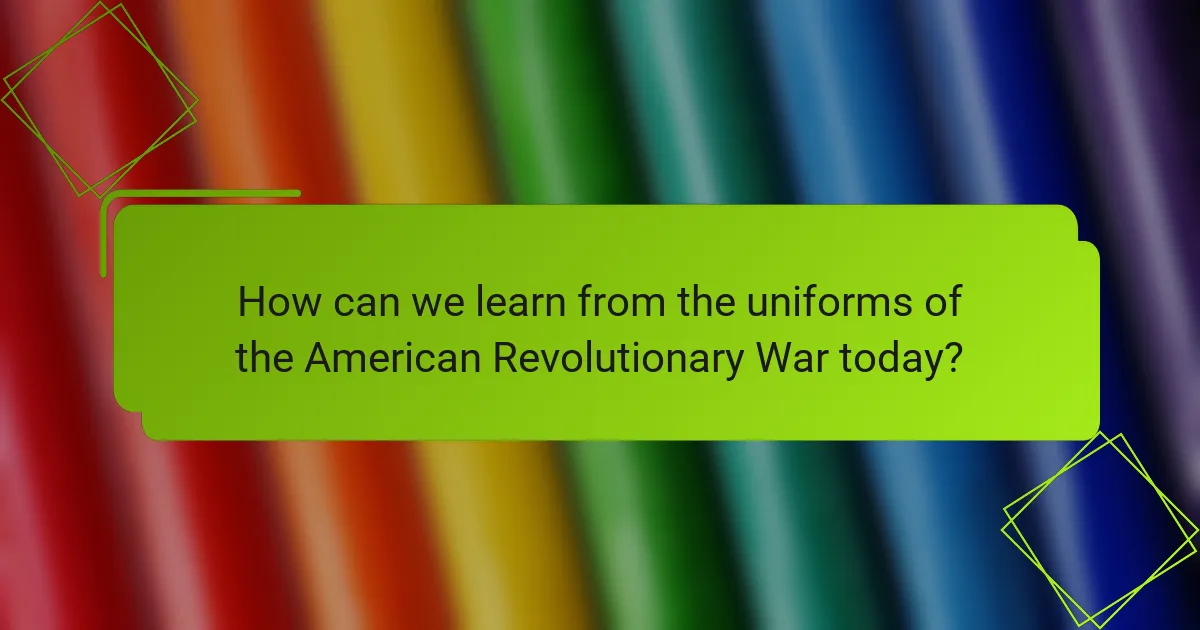
How can we learn from the uniforms of the American Revolutionary War today?
The uniforms of the American Revolutionary War provide insights into historical military practices and social structures. They reflect the color patterns and fabric choices that indicated rank and affiliation. For instance, British soldiers wore red coats, symbolizing their identity and authority. This color choice influenced modern military uniforms, emphasizing the importance of visual distinction. Additionally, the use of wool and linen in these uniforms informs contemporary fabric selection for durability and comfort. Understanding these historical choices can guide modern designers in creating functional and symbolic attire. The significance of rank differentiation through uniform design remains relevant in today’s military and organizational structures.
What insights can modern military organizations gain from historical uniforms?
Modern military organizations can gain valuable insights from historical uniforms, particularly in design and functionality. Historical uniforms, such as those from the American Revolutionary War, illustrate the importance of color patterns in identifying ranks and units. For example, distinct color combinations were used to signify different regiments, aiding in battlefield recognition.
Additionally, fabric choices from that era highlight the need for durability and comfort in uniforms. Many uniforms were made from wool or cotton blends, which provided insulation and breathability. Understanding these material properties can inform modern uniform design for various climates.
Furthermore, historical uniforms reflect the evolution of military identity and morale. They often included symbols and insignias that fostered a sense of belonging among troops. This can guide modern military organizations in creating uniforms that enhance unit cohesion.
Overall, analyzing historical uniforms offers lessons in practical design, identification, and psychological impact, which are relevant for contemporary military attire.
How can the study of these uniforms inform contemporary military design?
The study of American Revolutionary War uniforms can inform contemporary military design by highlighting effective color patterns and fabric choices. These historical uniforms utilized specific colors for rank differentiation and unit identification. For instance, bright colors like red and blue were used to enhance visibility and morale. Additionally, the choice of durable fabrics provided insights into functionality and comfort under various conditions. By analyzing these elements, modern military design can incorporate practical aesthetics that improve soldier performance and cohesion. Historical examples demonstrate that thoughtful design can enhance both the psychological and physical aspects of military uniforms.
What are some tips for researching historical military uniforms effectively?
To research historical military uniforms effectively, start by identifying primary sources. Examine military records, uniforms in museums, and period artwork. Utilize academic databases for scholarly articles on military history. Join online forums or groups focused on historical reenactment for firsthand insights. Visit libraries with specialized collections on military history. Reference books specifically about the American Revolutionary War uniforms. Analyze color patterns and fabric choices documented in historical texts. Cross-reference findings to ensure accuracy and gain a comprehensive understanding.
What resources are available for studying the uniforms of the American Revolutionary War?
Books, academic journals, and online databases are available for studying the uniforms of the American Revolutionary War. Notable books include “The American Revolution: A Visual History” by DK and “The Revolutionary War: A History in Documents” by David S. Heidler. Academic journals such as “The Journal of the American Revolution” provide articles on uniform details. Online databases like JSTOR and Google Scholar offer access to scholarly articles about military attire. Museums, including the Smithsonian and the British Museum, have collections and resources on Revolutionary War uniforms. These resources provide insights into color patterns, fabric choices, and rank differentiation.
How can enthusiasts engage with historical reenactments to learn more about uniforms?
Enthusiasts can engage with historical reenactments by participating in events that focus on uniforms. These events often feature demonstrations of period-specific attire. Participants can learn about fabric choices and color patterns used during the American Revolutionary War. Engaging in reenactments allows enthusiasts to experience the history firsthand. They can also interact with knowledgeable historians and fellow reenactors. Workshops and seminars at these events often cover uniform details and rank differentiation. This hands-on experience provides practical insights into historical clothing. By immersing themselves in these activities, enthusiasts gain a deeper understanding of the significance of uniforms.
The main entity of this article is the uniforms of the American Revolutionary War, which are characterized by distinct color patterns, fabric choices, and rank differentiation. Key discussions include the significance of color in identifying military units, with blue representing the Continental Army and red for British troops, as well as the materials used, primarily wool and linen, which affected durability and comfort. The article also explores how rank differentiation was visually communicated through uniform design, including insignia and embellishments. Additionally, it examines the challenges soldiers faced regarding uniform availability and maintenance, and how historical insights can inform contemporary military uniform design.
